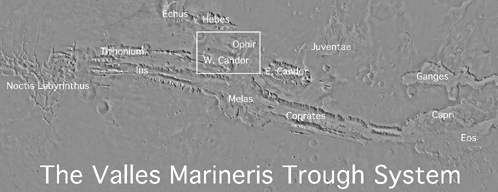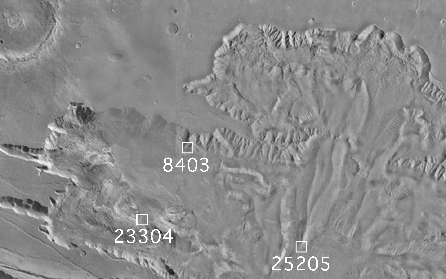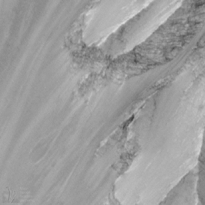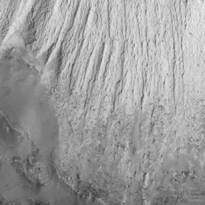
Mars Global Surveyor
Mars Orbiter Camera
Mars Orbiter Camera (MOC) High Resolution Images
Western Candor Chasma, Valles Marineris
Mars Global Surveyor Mars Orbiter Camera Release: MOC2-59a, -59b, -59c, -59d, -59e
Mars Global Surveyor Mars Orbiter Camera Image ID: 568534375.8403
P084-03 (C, below);
576779012.23304
P233-04 (D, below);
577575955.25205
P252-05 (E, below).
(A)

270 KByte GIF image
(A) The Valles Marineris trough system is more than 4,000 kilometers
(2500 miles) in length. Each "Chasma" that makes up the trough
system is labeled
above (e.g., Ophir is "Ophir Chasma"). White box indicates the
location of the context image shown below in (B). Three MOC
images within this box are presented in (C), (D), and (E).
Picture is a mosaic of Viking Orbiter images from
the U.S. Geological Survey. North is up.
(B)

113 KByte GIF image
(B) Western Candor Chasma. Small white boxes indicate the approximate
locations of each of the MOC images shown below. Each box
is labeled with an image number--8403 is the third image from Mars
Global Surveyor orbit 84 (shown in (C), below); 23304 is the fourth
image from orbit 233 (D, below); and 25205 is the fifth image from
orbit 252 (E, below).
Picture is a mosaic of Viking Orbiter images from
the U.S. Geological Survey. North is up.
(C)

136 KByte GIF image
(C) Layers in western Candor Chasma northern wall. MOC image 8403
subframe shown at full resolution of 4.6 meters (15 feet) per
pixel. The image shows an area approximately 2.4 by 2.5 kilometers
(1.5 x 1.6 miles). North is up, illumination is from the left.
Image 8403 was obtained during Mars Global Surveyor's 84th
orbit at 10:12 p.m. (PST) on January 6, 1998.
(D)

291 KByte GIF image
(D) Layers exposed near the middle of western Candor Chasma. MOC image
23304 subframe shown at 10.7 meters (35 feet) per pixel. Two
layered buttes (upper right and lower right) and a layered or
stepped mesa (center right) are shown. The image covers an
area approximately 5.5 by 5.5 kilometers (3.4 x 3.4 miles).
North is approximately up, illumination is from the lower right.
Image 23304 was obtained during Mars Global Surveyor's 233rd
orbit at 9:23 a.m. (PDT) on April 11, 1998.
(E)

273 KByte GIF image
(E) Massive (non-layered) material exposed in central Candor Chasma.
MOC image 25205 subframe shown at 11.7 meters (38.4 feet) per
pixel resolution. Image shows the southern tip of
a massive "interior deposit" that points like a giant tongue
from Ophir Chasma (to the north) down into the center of
Candor Chasma. The ridged and grooved bright unit is the
"interior deposit". South of this ridged unit is a low
elevation surface mantled by dark dunes and sand. Image covers
an area approximately 5.7 by 5.7 kilometers (3.5 x 3.5 miles).
North is approximately up, illumination is from the lower right.
Image 25205 was obtained during Mars Global Surveyor's 252nd
orbit at 2:45 p.m. (PDT) on April 20, 1998.
You may need to adjust the images for the gamma of your monitor to
insure proper viewing.
|
Note: This MOC image is made available
in order to share with the public the excitement of new
discoveries being made via the Mars Global Surveyor spacecraft.
The image may be reproduced only if the
image is credited to "Malin Space Science Systems/NASA".
Release of this image does not constitute a release of
scientific data. The image and its caption should not be
referenced in the scientific literature. Full data releases
to the scientific community are scheduled by the Mars Global
Surveyor Project and NASA Planetary Data System. Typically, data
will be released after a 6 month calibration and validation period.
Click Here for more information on MGS data release and
archiving plans.
|
CAPTION
One of the most striking discoveries of the Mars Global Surveyor
mission has been the identification of thousands of meters/feet of
layers within the wall rock of the enormous martian canyon system,
Valles Marineris.
Valles Marineris was first observed in 1972 by the Mariner 9 spacecraft,
from which the troughs get their name: Valles--valleys,
Marineris--Mariner.
Some hints of layering in both the canyon walls and within some
deposits on the canyon floors were seen in Mariner 9 and Viking
orbiter images from the 1970s. The Mars Orbiter Camera on board Mars
Global Surveyor has been examining these layers at much higher
resolution than was available previously.
MOC images led to the realization that there are layers in
the walls that go down to great depths. An example of the wall rock
layers can be seen in MOC image 8403, shown above (C).
MOC images also reveal amazing layered outcrops on the floors of
some of the Valles Marineris canyons. Particularly noteworthy is
MOC image 23304 (D, above), which shows extensive, horizontally-bedded
layers exposed in buttes and mesas on the floor of western Candor Chasma.
These layered rocks might be the same material as is exposed in the
chasm walls (as in 8403--C, above), or they might be rocks that formed
by deposition (from water, wind, and/or volcanism) long after Candor
Chasma opened up.
In addition to layered materials in the walls and on the floors of the
Valles Marineris system, MOC images are helping to refine our
classification of geologic features that occur within the canyons.
For example, MOC image 25205 (E, above), shows the southern tip of a
massive, tongue-shaped massif (a mountainous ridge) that was
previously identified as a layered deposit. However, this MOC image
does not show layering. The material has been sculpted by wind and
mass-wasting--downslope movement of debris--but no obvious
layers were exposed by these processes.
Valles Marineris is a fascinating region on Mars that holds much
potential to reveal information about the early history and evolution
of the red planet. The MOC Science Team is continuing to examine the
wealth of new data and planning for new Valles Marineris targets once
the Mapping Phase of the Mars Global Surveyor mission commences in
March 1999.
Malin Space Science Systems and the California Institute of
Technology built the MOC using spare hardware from the Mars Observer
mission. MSSS operates the camera from its facilities in San Diego,
CA. The Jet Propulsion Laboratory's Mars Surveyor Operations Project
operates the Mars Global Surveyor spacecraft with its industrial
partner, Lockheed Martin Astronautics, from facilities in Pasadena, CA
and Denver, CO.
 To MSSS Home Page
To MSSS Home Page
Contact: info@msss.com


